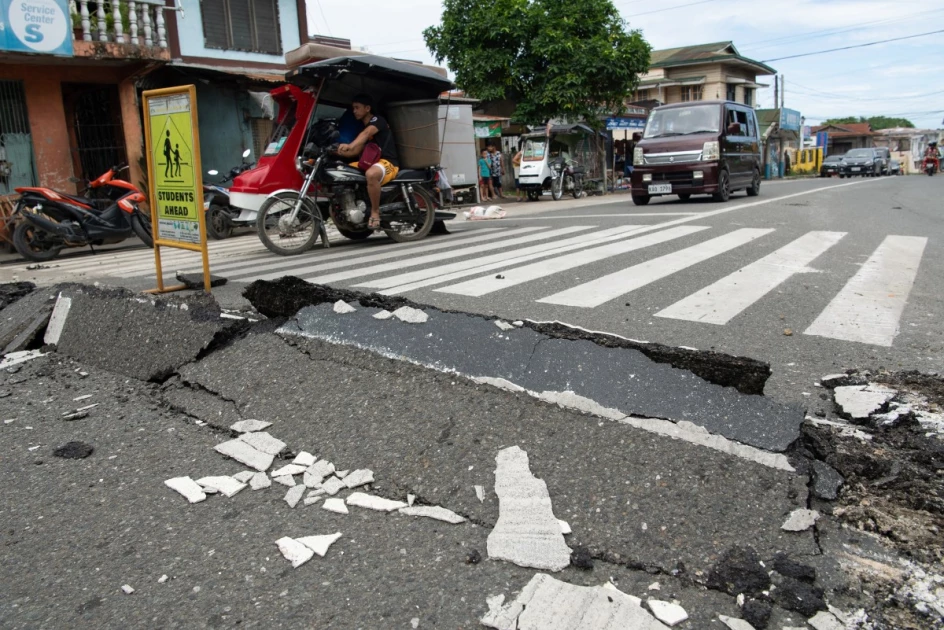Philippines quake kills dozens as injured overwhelm hospitals

Vehicles maneuver past a damaged part of a road in Bogo City on October 1, 2025, after a powerful 6.9 magnitude earthquake jolted the central Philippines, killing dozens on the island of Cebu with fears the toll could rise.

Audio By Vocalize
Injured children cried and adults screamed while being treated on beds beneath blue tents outside the Cebu Provincial Hospital, having been wheeled out as a precaution against waves of aftershocks overnight.
They are survivors of the shallow magnitude 6.9 quake that struck late Tuesday off Cebu island's northern end near Bogo, a city of 90,000 people, according to the US Geological Survey (USGS).
But others were not so fortunate, and AFP journalists saw hospital workers loading black body bags into vans that will take the quake dead to local mortuaries.
"We are receiving additional numbers of reported casualties so this thing is very fluid," Office of Civil Defence deputy administrator Rafaelito Alejandro told reporters in Manila, putting the reported death toll at up to 60.
The Bogo hospital listed 53 confirmed deaths, 30 of them from Bogo, and 154 injured.
Richard Guion, his left elbow heavily bandaged, recounted how he and his wife, who broke her foot, were dug from under the collapsed concrete wall of their home by their 17-year-old son, who had been playing outside with his mobile phone when the quake struck.
"When the cement collapsed, I called out to him," said the 39-year-old Guion, thankful his son ignored his earlier order to go to bed early.
Rescuer Teddy Fontillas, 56, told AFP he had not slept a wink as he helped transfer the injured to other hospitals because the one in Bogo was already overflowing.
"I'm already struggling, but what we are doing is necessary to help our patients," he added.
Elsewhere in Bogo, firemen used excavators to drill holes into the collapsed heap of a two-storey motel, where two receptionists and a child were feared trapped beneath debris.
"We cannot give up even if we have been searching for around five hours now," fireman Erwin Castaneda told AFP, adding: "We are talking about lives here. We will do everything that we can."
"I offer my heartfelt condolences to the bereaved families," President Ferdinand Marcos said in a statement in which he pledged swift aid.
Dramatic footage filmed by residents and widely shared on social media showed an old Catholic church on Bantayan island near Cebu adorned with a string of light bulbs swaying wildly shortly before its belfry tumbled into the courtyard.
Local television showed riders dismounting from their motorcycles and holding onto the railings as a Cebu bridge violently rocked.
In Cebu city, 100 kilometres (62 miles) to the south, online shoe merchant Jayford Maranga, said he hid under a restaurant table to avoid the collapsing metal ceiling of a shopping mall.
"My friend and I ate at the food court near closing time, and then, bang! It was as if the Earth stopped spinning. And then the mall started shaking," 21-year-old Maranga told AFP, adding his friend was slightly injured.
The Cebu provincial government has put out a call on its official Facebook page for medical volunteers to assist in the aftermath of the quake.
A number of village roads also sustained damage. In Tabogon town, the road was riddled with five-centimetre (two-inch) cracks, AFP journalists saw.
Quakes are a near-daily occurrence in the Philippines, which is situated on the Pacific "Ring of Fire", an arc of intense seismic activity stretching from Japan through Southeast Asia and across the Pacific basin.
Most are too weak to be felt by humans, but strong and destructive ones come at random, with no technology available to predict when and where they might strike.


Leave a Comment